Comprehensive Report: Communication in the Business Environment
VerifiedAdded on 2020/06/04
|12
|3418
|72
Report
AI Summary
This report provides a comprehensive overview of communication within a business environment. It explores the communication needs of internal and external stakeholders, examining various communication models such as Aristotle's, Lasswell's, and Schramm's. The report analyzes the effectiveness of different communication systems, factors influencing media choice, and the importance of grammar, sentence structure, and spelling. It delves into planning and structuring communication, overcoming barriers, and applying communication theories and body language. The report also covers proofreading techniques, identifying the purpose and audience of communication, selecting appropriate media, and presenting information in formal layouts. It emphasizes following business practices, adapting communication style, and ensuring clarity and accuracy. Furthermore, the report addresses meeting deadlines, using appropriate language and body language, and confirming message understanding, all in accordance with organizational policies.
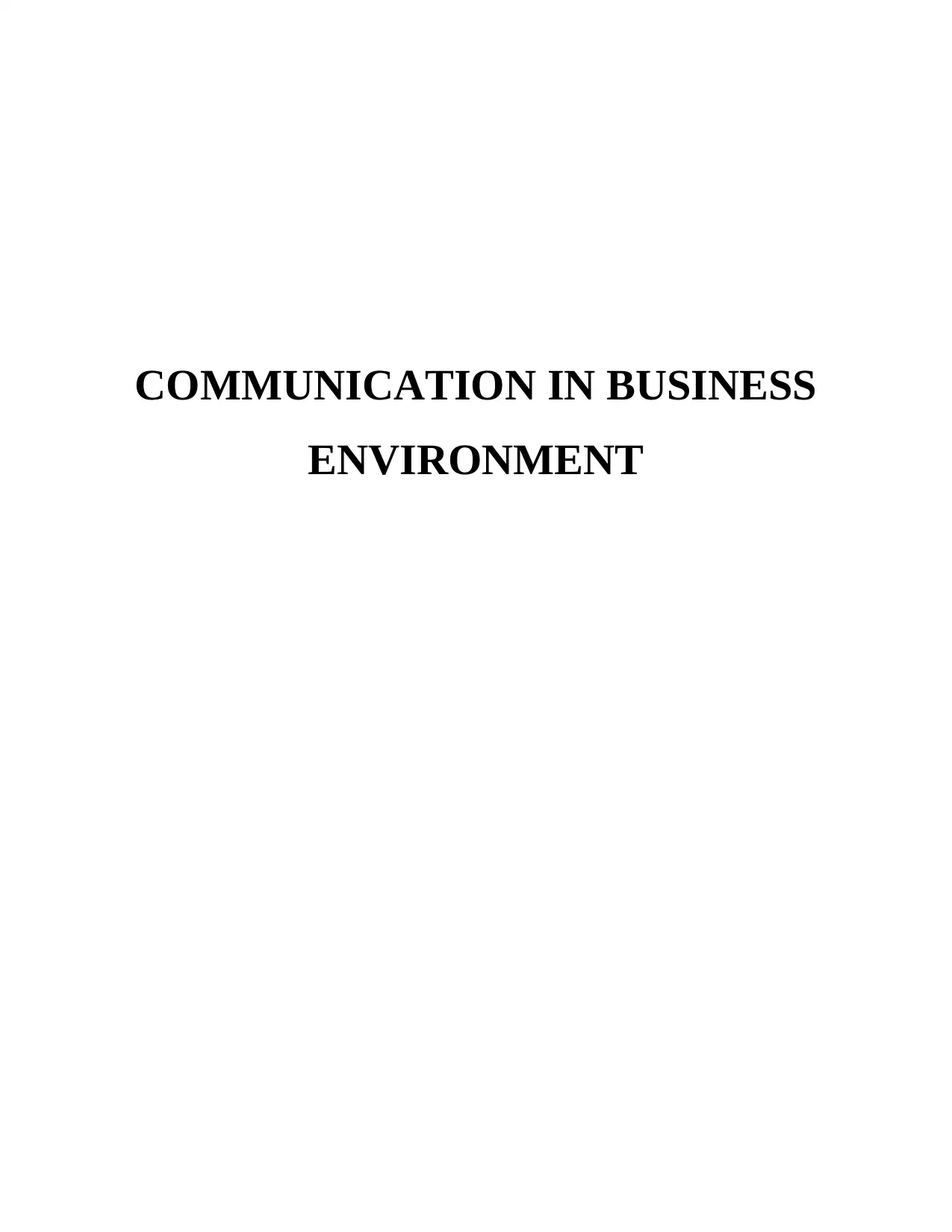
COMMUNICATION IN BUSINESS
ENVIRONMENT
ENVIRONMENT
Paraphrase This Document
Need a fresh take? Get an instant paraphrase of this document with our AI Paraphraser
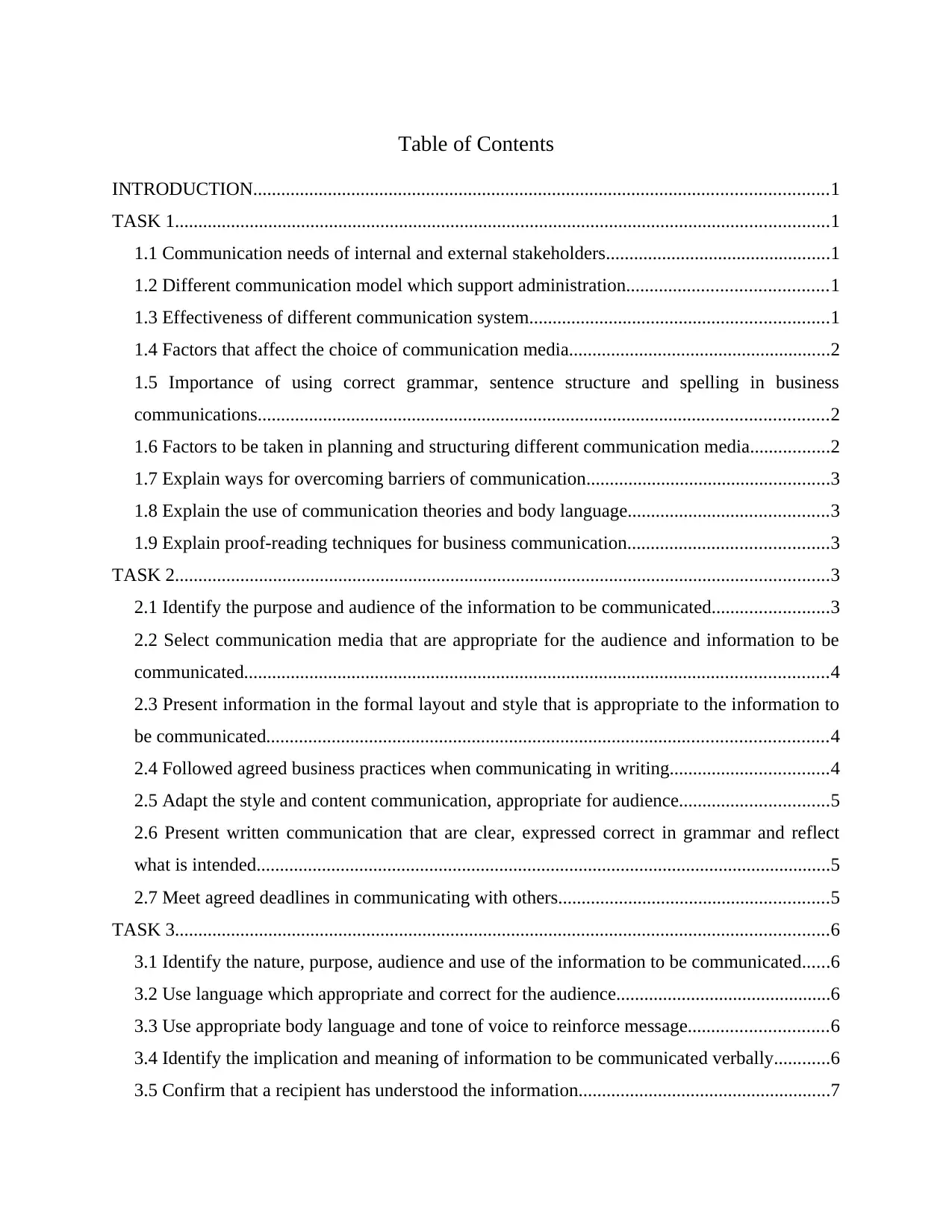
Table of Contents
INTRODUCTION...........................................................................................................................1
TASK 1............................................................................................................................................1
1.1 Communication needs of internal and external stakeholders................................................1
1.2 Different communication model which support administration...........................................1
1.3 Effectiveness of different communication system................................................................1
1.4 Factors that affect the choice of communication media........................................................2
1.5 Importance of using correct grammar, sentence structure and spelling in business
communications..........................................................................................................................2
1.6 Factors to be taken in planning and structuring different communication media.................2
1.7 Explain ways for overcoming barriers of communication....................................................3
1.8 Explain the use of communication theories and body language...........................................3
1.9 Explain proof-reading techniques for business communication...........................................3
TASK 2............................................................................................................................................3
2.1 Identify the purpose and audience of the information to be communicated.........................3
2.2 Select communication media that are appropriate for the audience and information to be
communicated.............................................................................................................................4
2.3 Present information in the formal layout and style that is appropriate to the information to
be communicated........................................................................................................................4
2.4 Followed agreed business practices when communicating in writing..................................4
2.5 Adapt the style and content communication, appropriate for audience................................5
2.6 Present written communication that are clear, expressed correct in grammar and reflect
what is intended...........................................................................................................................5
2.7 Meet agreed deadlines in communicating with others..........................................................5
TASK 3............................................................................................................................................6
3.1 Identify the nature, purpose, audience and use of the information to be communicated......6
3.2 Use language which appropriate and correct for the audience..............................................6
3.3 Use appropriate body language and tone of voice to reinforce message..............................6
3.4 Identify the implication and meaning of information to be communicated verbally............6
3.5 Confirm that a recipient has understood the information......................................................7
INTRODUCTION...........................................................................................................................1
TASK 1............................................................................................................................................1
1.1 Communication needs of internal and external stakeholders................................................1
1.2 Different communication model which support administration...........................................1
1.3 Effectiveness of different communication system................................................................1
1.4 Factors that affect the choice of communication media........................................................2
1.5 Importance of using correct grammar, sentence structure and spelling in business
communications..........................................................................................................................2
1.6 Factors to be taken in planning and structuring different communication media.................2
1.7 Explain ways for overcoming barriers of communication....................................................3
1.8 Explain the use of communication theories and body language...........................................3
1.9 Explain proof-reading techniques for business communication...........................................3
TASK 2............................................................................................................................................3
2.1 Identify the purpose and audience of the information to be communicated.........................3
2.2 Select communication media that are appropriate for the audience and information to be
communicated.............................................................................................................................4
2.3 Present information in the formal layout and style that is appropriate to the information to
be communicated........................................................................................................................4
2.4 Followed agreed business practices when communicating in writing..................................4
2.5 Adapt the style and content communication, appropriate for audience................................5
2.6 Present written communication that are clear, expressed correct in grammar and reflect
what is intended...........................................................................................................................5
2.7 Meet agreed deadlines in communicating with others..........................................................5
TASK 3............................................................................................................................................6
3.1 Identify the nature, purpose, audience and use of the information to be communicated......6
3.2 Use language which appropriate and correct for the audience..............................................6
3.3 Use appropriate body language and tone of voice to reinforce message..............................6
3.4 Identify the implication and meaning of information to be communicated verbally............6
3.5 Confirm that a recipient has understood the information......................................................7
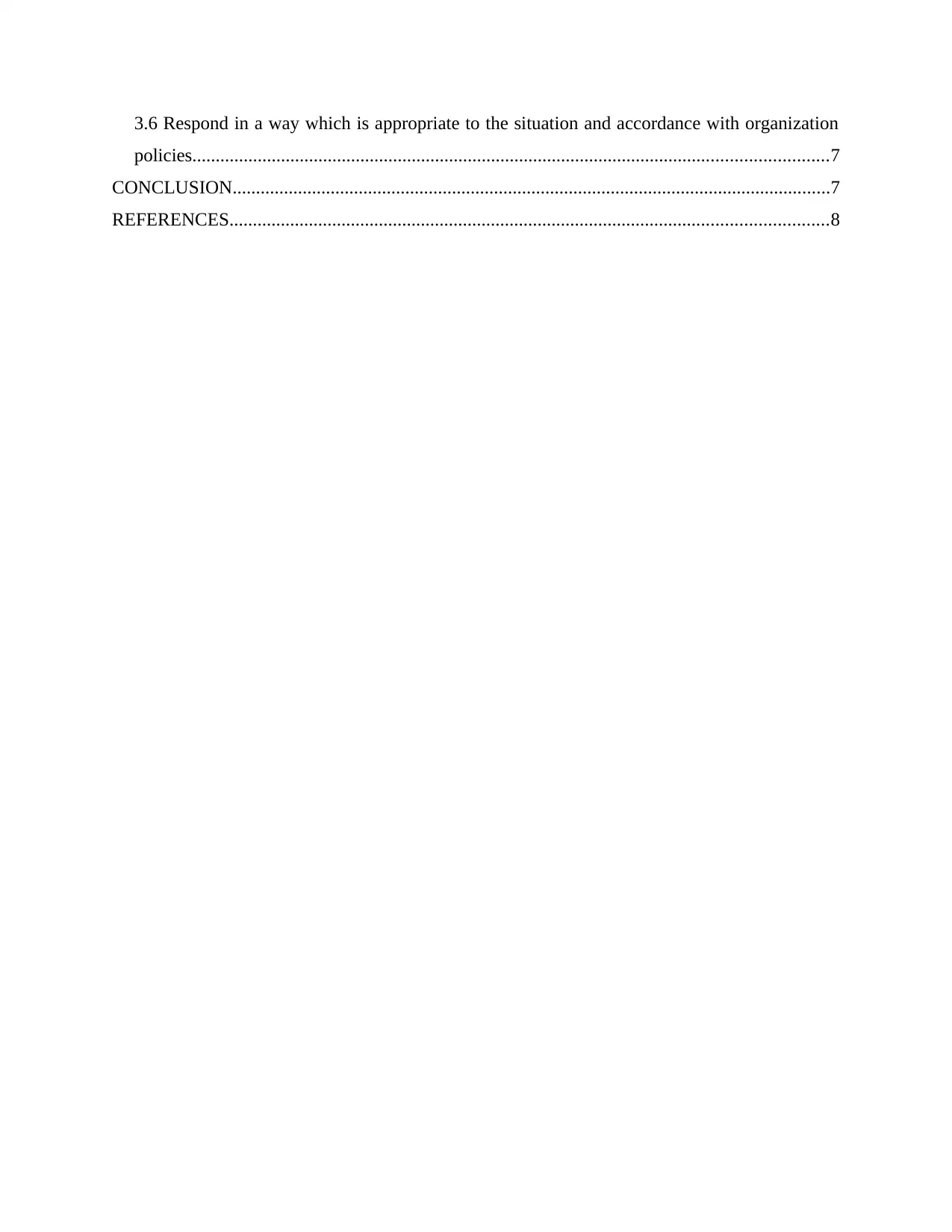
3.6 Respond in a way which is appropriate to the situation and accordance with organization
policies........................................................................................................................................7
CONCLUSION................................................................................................................................7
REFERENCES................................................................................................................................8
policies........................................................................................................................................7
CONCLUSION................................................................................................................................7
REFERENCES................................................................................................................................8
⊘ This is a preview!⊘
Do you want full access?
Subscribe today to unlock all pages.

Trusted by 1+ million students worldwide
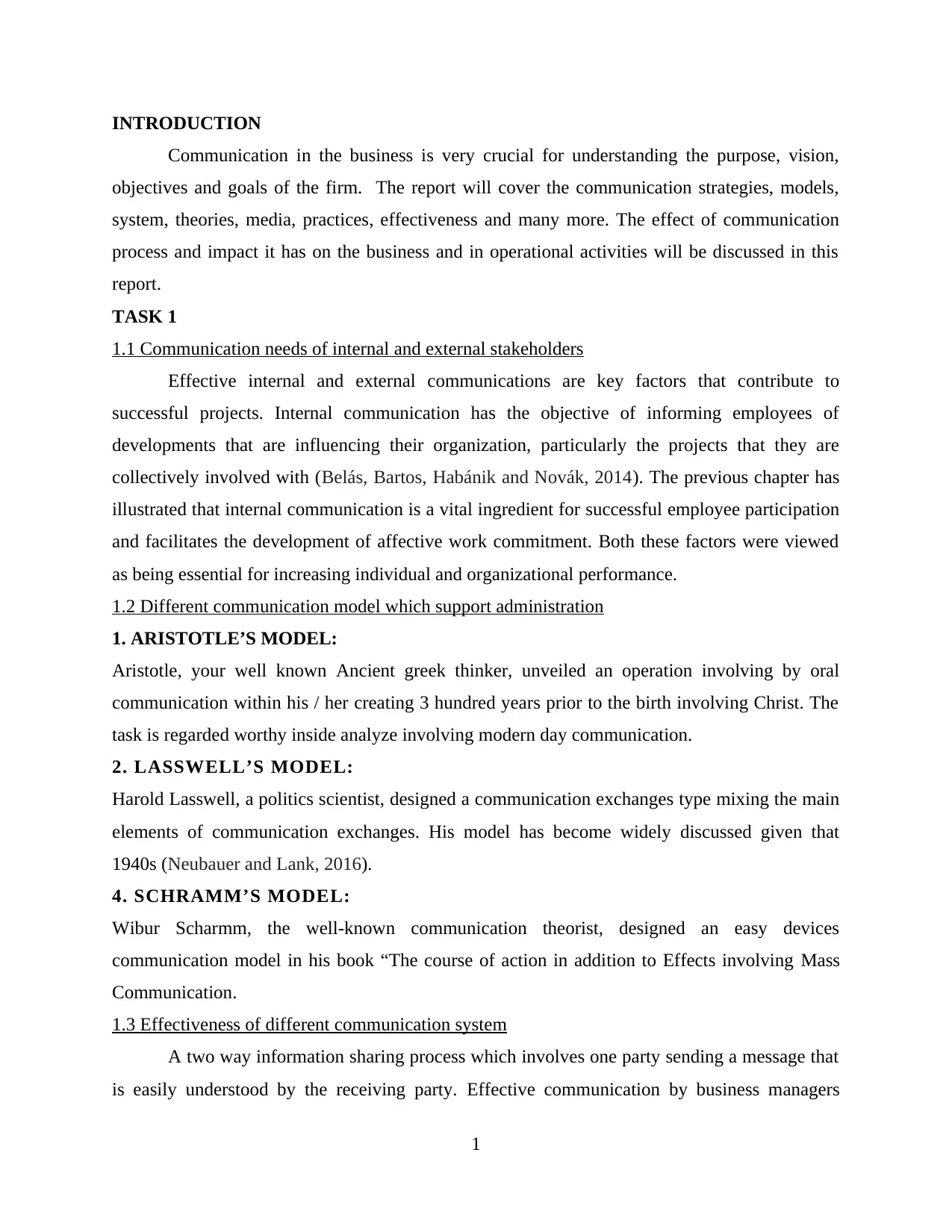
INTRODUCTION
Communication in the business is very crucial for understanding the purpose, vision,
objectives and goals of the firm. The report will cover the communication strategies, models,
system, theories, media, practices, effectiveness and many more. The effect of communication
process and impact it has on the business and in operational activities will be discussed in this
report.
TASK 1
1.1 Communication needs of internal and external stakeholders
Effective internal and external communications are key factors that contribute to
successful projects. Internal communication has the objective of informing employees of
developments that are influencing their organization, particularly the projects that they are
collectively involved with (Belás, Bartos, Habánik and Novák, 2014). The previous chapter has
illustrated that internal communication is a vital ingredient for successful employee participation
and facilitates the development of affective work commitment. Both these factors were viewed
as being essential for increasing individual and organizational performance.
1.2 Different communication model which support administration
1. ARISTOTLE’S MODEL:
Aristotle, your well known Ancient greek thinker, unveiled an operation involving by oral
communication within his / her creating 3 hundred years prior to the birth involving Christ. The
task is regarded worthy inside analyze involving modern day communication.
2. LASSWELL’S MODEL:
Harold Lasswell, a politics scientist, designed a communication exchanges type mixing the main
elements of communication exchanges. His model has become widely discussed given that
1940s (Neubauer and Lank, 2016).
4. SCHRAMM’S MODEL:
Wibur Scharmm, the well-known communication theorist, designed an easy devices
communication model in his book “The course of action in addition to Effects involving Mass
Communication.
1.3 Effectiveness of different communication system
A two way information sharing process which involves one party sending a message that
is easily understood by the receiving party. Effective communication by business managers
1
Communication in the business is very crucial for understanding the purpose, vision,
objectives and goals of the firm. The report will cover the communication strategies, models,
system, theories, media, practices, effectiveness and many more. The effect of communication
process and impact it has on the business and in operational activities will be discussed in this
report.
TASK 1
1.1 Communication needs of internal and external stakeholders
Effective internal and external communications are key factors that contribute to
successful projects. Internal communication has the objective of informing employees of
developments that are influencing their organization, particularly the projects that they are
collectively involved with (Belás, Bartos, Habánik and Novák, 2014). The previous chapter has
illustrated that internal communication is a vital ingredient for successful employee participation
and facilitates the development of affective work commitment. Both these factors were viewed
as being essential for increasing individual and organizational performance.
1.2 Different communication model which support administration
1. ARISTOTLE’S MODEL:
Aristotle, your well known Ancient greek thinker, unveiled an operation involving by oral
communication within his / her creating 3 hundred years prior to the birth involving Christ. The
task is regarded worthy inside analyze involving modern day communication.
2. LASSWELL’S MODEL:
Harold Lasswell, a politics scientist, designed a communication exchanges type mixing the main
elements of communication exchanges. His model has become widely discussed given that
1940s (Neubauer and Lank, 2016).
4. SCHRAMM’S MODEL:
Wibur Scharmm, the well-known communication theorist, designed an easy devices
communication model in his book “The course of action in addition to Effects involving Mass
Communication.
1.3 Effectiveness of different communication system
A two way information sharing process which involves one party sending a message that
is easily understood by the receiving party. Effective communication by business managers
1
Paraphrase This Document
Need a fresh take? Get an instant paraphrase of this document with our AI Paraphraser
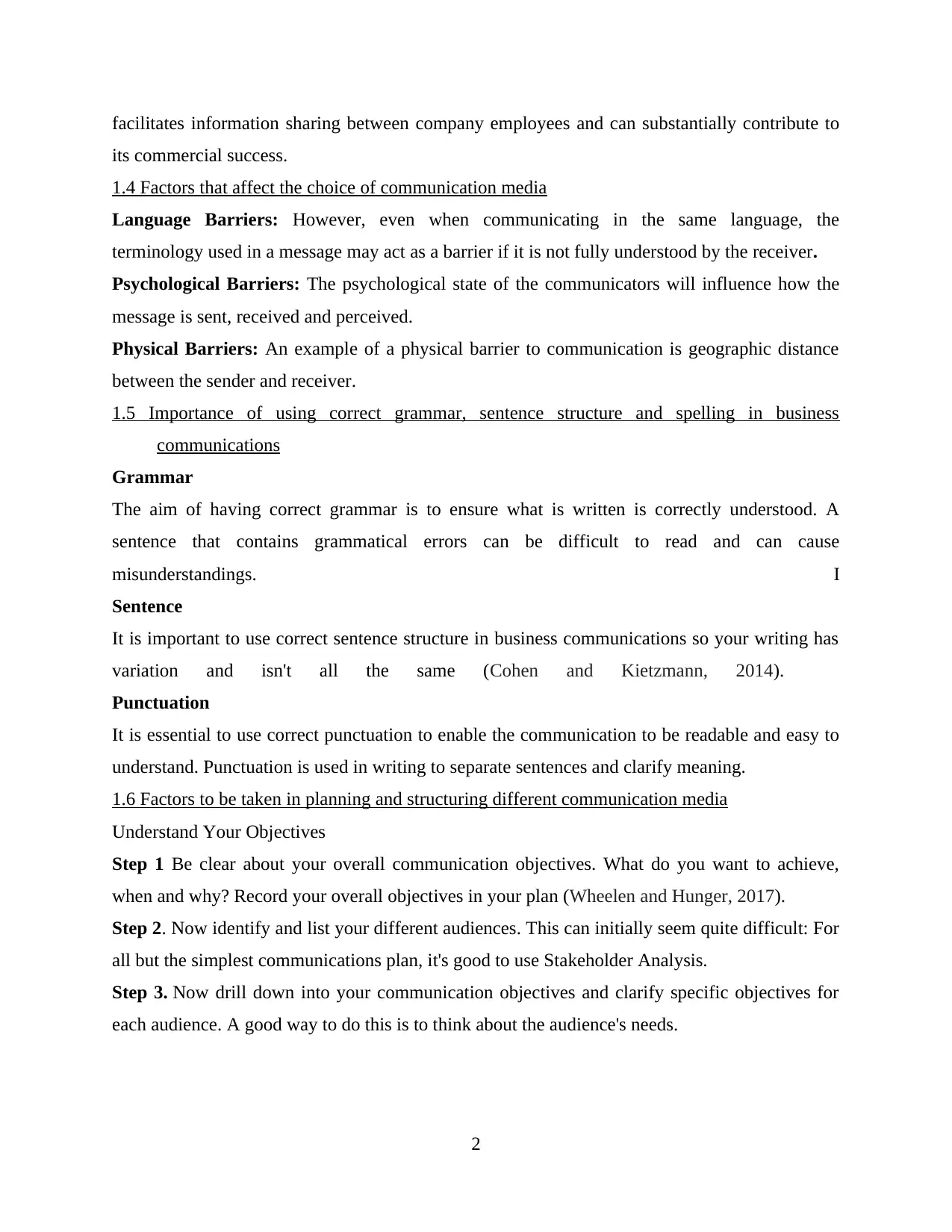
facilitates information sharing between company employees and can substantially contribute to
its commercial success.
1.4 Factors that affect the choice of communication media
Language Barriers: However, even when communicating in the same language, the
terminology used in a message may act as a barrier if it is not fully understood by the receiver.
Psychological Barriers: The psychological state of the communicators will influence how the
message is sent, received and perceived.
Physical Barriers: An example of a physical barrier to communication is geographic distance
between the sender and receiver.
1.5 Importance of using correct grammar, sentence structure and spelling in business
communications
Grammar
The aim of having correct grammar is to ensure what is written is correctly understood. A
sentence that contains grammatical errors can be difficult to read and can cause
misunderstandings. I
Sentence
It is important to use correct sentence structure in business communications so your writing has
variation and isn't all the same (Cohen and Kietzmann, 2014).
Punctuation
It is essential to use correct punctuation to enable the communication to be readable and easy to
understand. Punctuation is used in writing to separate sentences and clarify meaning.
1.6 Factors to be taken in planning and structuring different communication media
Understand Your Objectives
Step 1 Be clear about your overall communication objectives. What do you want to achieve,
when and why? Record your overall objectives in your plan (Wheelen and Hunger, 2017).
Step 2. Now identify and list your different audiences. This can initially seem quite difficult: For
all but the simplest communications plan, it's good to use Stakeholder Analysis.
Step 3. Now drill down into your communication objectives and clarify specific objectives for
each audience. A good way to do this is to think about the audience's needs.
2
its commercial success.
1.4 Factors that affect the choice of communication media
Language Barriers: However, even when communicating in the same language, the
terminology used in a message may act as a barrier if it is not fully understood by the receiver.
Psychological Barriers: The psychological state of the communicators will influence how the
message is sent, received and perceived.
Physical Barriers: An example of a physical barrier to communication is geographic distance
between the sender and receiver.
1.5 Importance of using correct grammar, sentence structure and spelling in business
communications
Grammar
The aim of having correct grammar is to ensure what is written is correctly understood. A
sentence that contains grammatical errors can be difficult to read and can cause
misunderstandings. I
Sentence
It is important to use correct sentence structure in business communications so your writing has
variation and isn't all the same (Cohen and Kietzmann, 2014).
Punctuation
It is essential to use correct punctuation to enable the communication to be readable and easy to
understand. Punctuation is used in writing to separate sentences and clarify meaning.
1.6 Factors to be taken in planning and structuring different communication media
Understand Your Objectives
Step 1 Be clear about your overall communication objectives. What do you want to achieve,
when and why? Record your overall objectives in your plan (Wheelen and Hunger, 2017).
Step 2. Now identify and list your different audiences. This can initially seem quite difficult: For
all but the simplest communications plan, it's good to use Stakeholder Analysis.
Step 3. Now drill down into your communication objectives and clarify specific objectives for
each audience. A good way to do this is to think about the audience's needs.
2
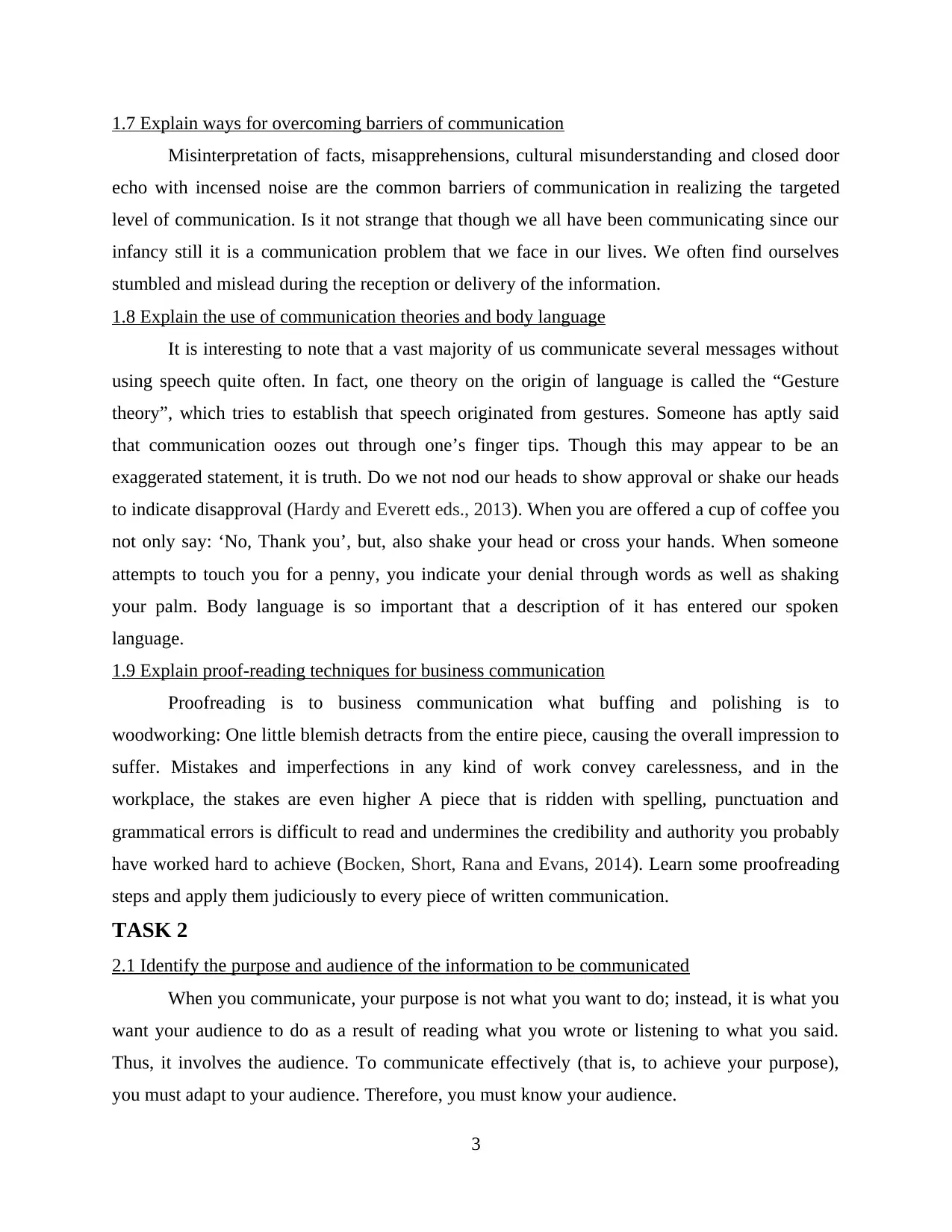
1.7 Explain ways for overcoming barriers of communication
Misinterpretation of facts, misapprehensions, cultural misunderstanding and closed door
echo with incensed noise are the common barriers of communication in realizing the targeted
level of communication. Is it not strange that though we all have been communicating since our
infancy still it is a communication problem that we face in our lives. We often find ourselves
stumbled and mislead during the reception or delivery of the information.
1.8 Explain the use of communication theories and body language
It is interesting to note that a vast majority of us communicate several messages without
using speech quite often. In fact, one theory on the origin of language is called the “Gesture
theory”, which tries to establish that speech originated from gestures. Someone has aptly said
that communication oozes out through one’s finger tips. Though this may appear to be an
exaggerated statement, it is truth. Do we not nod our heads to show approval or shake our heads
to indicate disapproval (Hardy and Everett eds., 2013). When you are offered a cup of coffee you
not only say: ‘No, Thank you’, but, also shake your head or cross your hands. When someone
attempts to touch you for a penny, you indicate your denial through words as well as shaking
your palm. Body language is so important that a description of it has entered our spoken
language.
1.9 Explain proof-reading techniques for business communication
Proofreading is to business communication what buffing and polishing is to
woodworking: One little blemish detracts from the entire piece, causing the overall impression to
suffer. Mistakes and imperfections in any kind of work convey carelessness, and in the
workplace, the stakes are even higher A piece that is ridden with spelling, punctuation and
grammatical errors is difficult to read and undermines the credibility and authority you probably
have worked hard to achieve (Bocken, Short, Rana and Evans, 2014). Learn some proofreading
steps and apply them judiciously to every piece of written communication.
TASK 2
2.1 Identify the purpose and audience of the information to be communicated
When you communicate, your purpose is not what you want to do; instead, it is what you
want your audience to do as a result of reading what you wrote or listening to what you said.
Thus, it involves the audience. To communicate effectively (that is, to achieve your purpose),
you must adapt to your audience. Therefore, you must know your audience.
3
Misinterpretation of facts, misapprehensions, cultural misunderstanding and closed door
echo with incensed noise are the common barriers of communication in realizing the targeted
level of communication. Is it not strange that though we all have been communicating since our
infancy still it is a communication problem that we face in our lives. We often find ourselves
stumbled and mislead during the reception or delivery of the information.
1.8 Explain the use of communication theories and body language
It is interesting to note that a vast majority of us communicate several messages without
using speech quite often. In fact, one theory on the origin of language is called the “Gesture
theory”, which tries to establish that speech originated from gestures. Someone has aptly said
that communication oozes out through one’s finger tips. Though this may appear to be an
exaggerated statement, it is truth. Do we not nod our heads to show approval or shake our heads
to indicate disapproval (Hardy and Everett eds., 2013). When you are offered a cup of coffee you
not only say: ‘No, Thank you’, but, also shake your head or cross your hands. When someone
attempts to touch you for a penny, you indicate your denial through words as well as shaking
your palm. Body language is so important that a description of it has entered our spoken
language.
1.9 Explain proof-reading techniques for business communication
Proofreading is to business communication what buffing and polishing is to
woodworking: One little blemish detracts from the entire piece, causing the overall impression to
suffer. Mistakes and imperfections in any kind of work convey carelessness, and in the
workplace, the stakes are even higher A piece that is ridden with spelling, punctuation and
grammatical errors is difficult to read and undermines the credibility and authority you probably
have worked hard to achieve (Bocken, Short, Rana and Evans, 2014). Learn some proofreading
steps and apply them judiciously to every piece of written communication.
TASK 2
2.1 Identify the purpose and audience of the information to be communicated
When you communicate, your purpose is not what you want to do; instead, it is what you
want your audience to do as a result of reading what you wrote or listening to what you said.
Thus, it involves the audience. To communicate effectively (that is, to achieve your purpose),
you must adapt to your audience. Therefore, you must know your audience.
3
⊘ This is a preview!⊘
Do you want full access?
Subscribe today to unlock all pages.

Trusted by 1+ million students worldwide
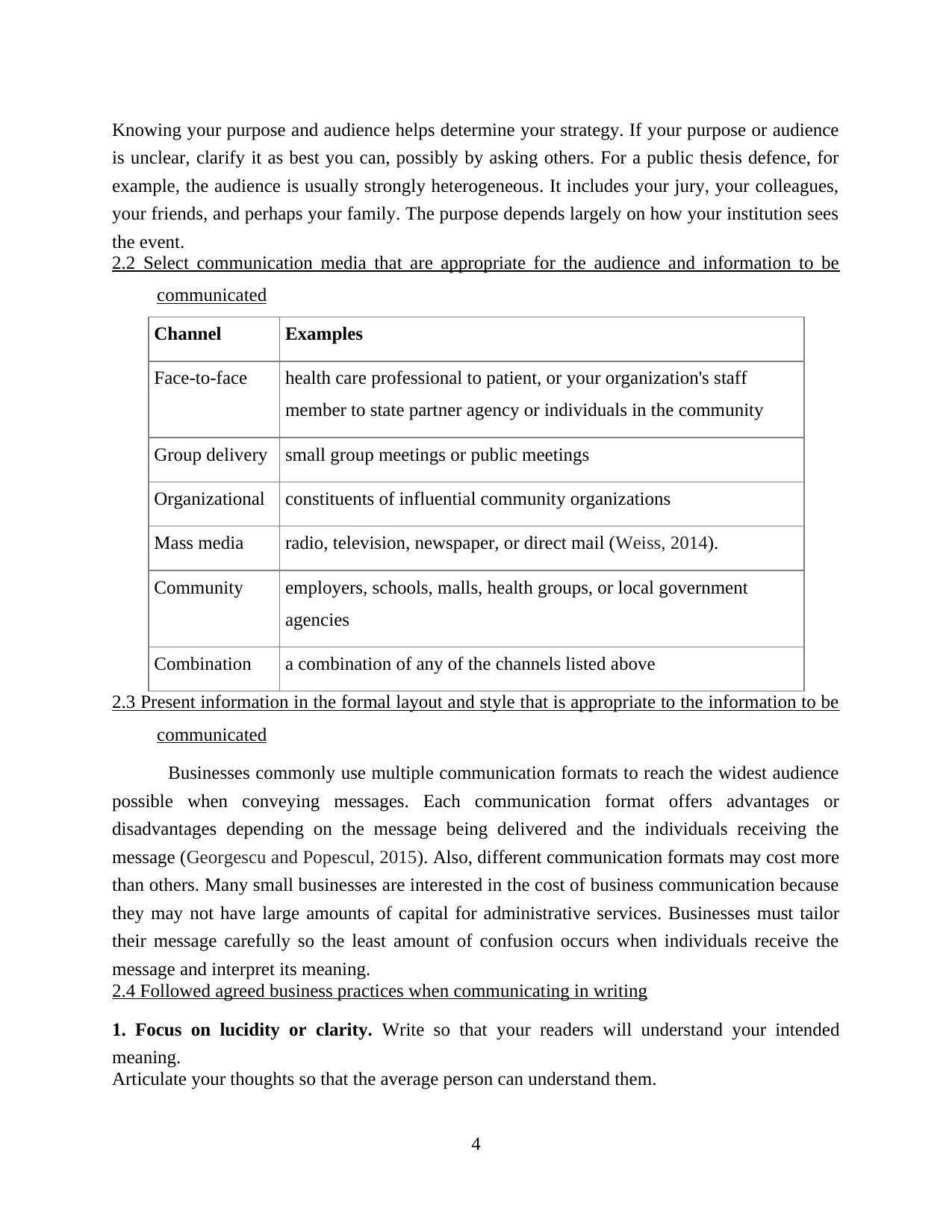
Knowing your purpose and audience helps determine your strategy. If your purpose or audience
is unclear, clarify it as best you can, possibly by asking others. For a public thesis defence, for
example, the audience is usually strongly heterogeneous. It includes your jury, your colleagues,
your friends, and perhaps your family. The purpose depends largely on how your institution sees
the event.
2.2 Select communication media that are appropriate for the audience and information to be
communicated
Channel Examples
Face-to-face health care professional to patient, or your organization's staff
member to state partner agency or individuals in the community
Group delivery small group meetings or public meetings
Organizational constituents of influential community organizations
Mass media radio, television, newspaper, or direct mail (Weiss, 2014).
Community employers, schools, malls, health groups, or local government
agencies
Combination a combination of any of the channels listed above
2.3 Present information in the formal layout and style that is appropriate to the information to be
communicated
Businesses commonly use multiple communication formats to reach the widest audience
possible when conveying messages. Each communication format offers advantages or
disadvantages depending on the message being delivered and the individuals receiving the
message (Georgescu and Popescul, 2015). Also, different communication formats may cost more
than others. Many small businesses are interested in the cost of business communication because
they may not have large amounts of capital for administrative services. Businesses must tailor
their message carefully so the least amount of confusion occurs when individuals receive the
message and interpret its meaning.
2.4 Followed agreed business practices when communicating in writing
1. Focus on lucidity or clarity. Write so that your readers will understand your intended
meaning.
Articulate your thoughts so that the average person can understand them.
4
is unclear, clarify it as best you can, possibly by asking others. For a public thesis defence, for
example, the audience is usually strongly heterogeneous. It includes your jury, your colleagues,
your friends, and perhaps your family. The purpose depends largely on how your institution sees
the event.
2.2 Select communication media that are appropriate for the audience and information to be
communicated
Channel Examples
Face-to-face health care professional to patient, or your organization's staff
member to state partner agency or individuals in the community
Group delivery small group meetings or public meetings
Organizational constituents of influential community organizations
Mass media radio, television, newspaper, or direct mail (Weiss, 2014).
Community employers, schools, malls, health groups, or local government
agencies
Combination a combination of any of the channels listed above
2.3 Present information in the formal layout and style that is appropriate to the information to be
communicated
Businesses commonly use multiple communication formats to reach the widest audience
possible when conveying messages. Each communication format offers advantages or
disadvantages depending on the message being delivered and the individuals receiving the
message (Georgescu and Popescul, 2015). Also, different communication formats may cost more
than others. Many small businesses are interested in the cost of business communication because
they may not have large amounts of capital for administrative services. Businesses must tailor
their message carefully so the least amount of confusion occurs when individuals receive the
message and interpret its meaning.
2.4 Followed agreed business practices when communicating in writing
1. Focus on lucidity or clarity. Write so that your readers will understand your intended
meaning.
Articulate your thoughts so that the average person can understand them.
4
Paraphrase This Document
Need a fresh take? Get an instant paraphrase of this document with our AI Paraphraser
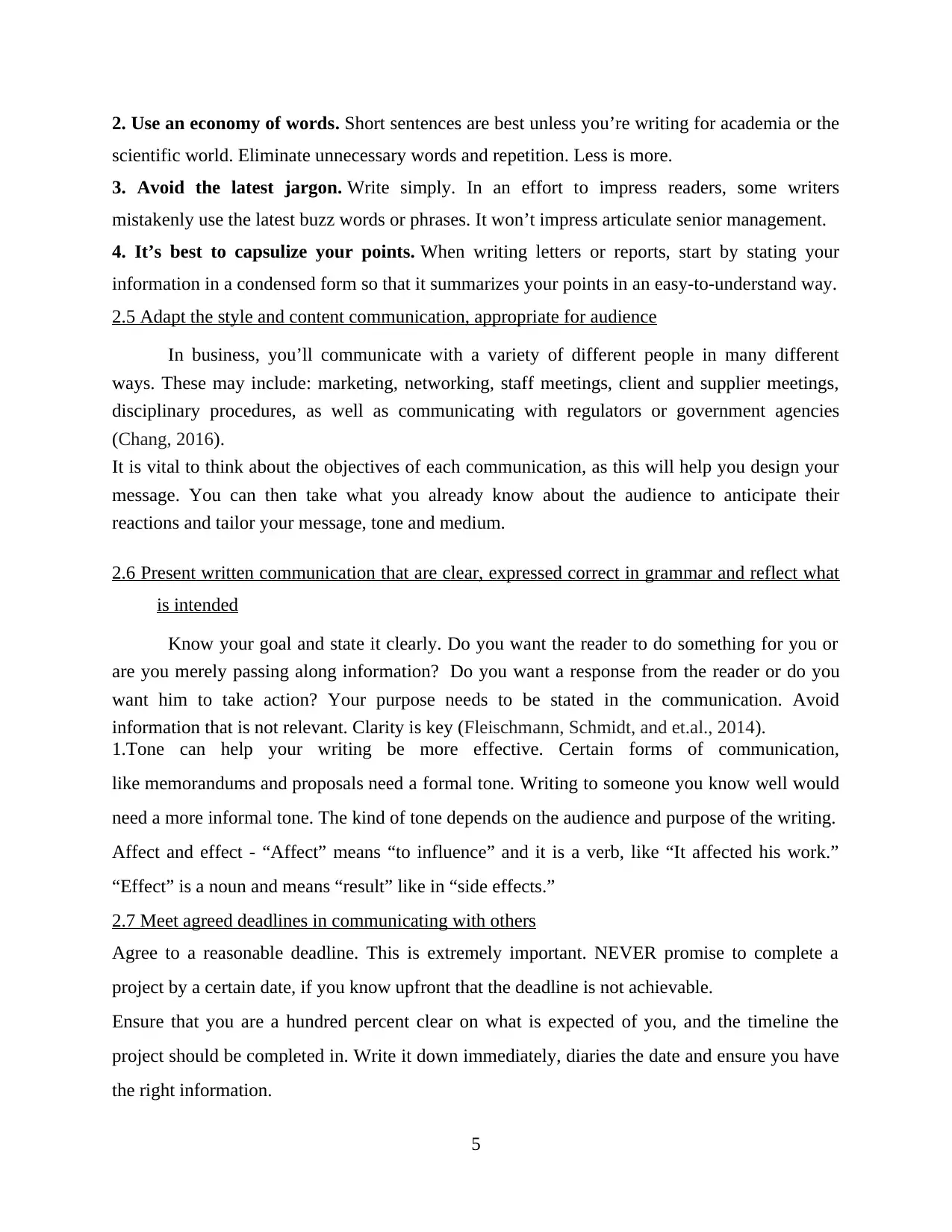
2. Use an economy of words. Short sentences are best unless you’re writing for academia or the
scientific world. Eliminate unnecessary words and repetition. Less is more.
3. Avoid the latest jargon. Write simply. In an effort to impress readers, some writers
mistakenly use the latest buzz words or phrases. It won’t impress articulate senior management.
4. It’s best to capsulize your points. When writing letters or reports, start by stating your
information in a condensed form so that it summarizes your points in an easy-to-understand way.
2.5 Adapt the style and content communication, appropriate for audience
In business, you’ll communicate with a variety of different people in many different
ways. These may include: marketing, networking, staff meetings, client and supplier meetings,
disciplinary procedures, as well as communicating with regulators or government agencies
(Chang, 2016).
It is vital to think about the objectives of each communication, as this will help you design your
message. You can then take what you already know about the audience to anticipate their
reactions and tailor your message, tone and medium.
2.6 Present written communication that are clear, expressed correct in grammar and reflect what
is intended
Know your goal and state it clearly. Do you want the reader to do something for you or
are you merely passing along information? Do you want a response from the reader or do you
want him to take action? Your purpose needs to be stated in the communication. Avoid
information that is not relevant. Clarity is key (Fleischmann, Schmidt, and et.al., 2014).
1.Tone can help your writing be more effective. Certain forms of communication,
like memorandums and proposals need a formal tone. Writing to someone you know well would
need a more informal tone. The kind of tone depends on the audience and purpose of the writing.
Affect and effect - “Affect” means “to influence” and it is a verb, like “It affected his work.”
“Effect” is a noun and means “result” like in “side effects.”
2.7 Meet agreed deadlines in communicating with others
Agree to a reasonable deadline. This is extremely important. NEVER promise to complete a
project by a certain date, if you know upfront that the deadline is not achievable.
Ensure that you are a hundred percent clear on what is expected of you, and the timeline the
project should be completed in. Write it down immediately, diaries the date and ensure you have
the right information.
5
scientific world. Eliminate unnecessary words and repetition. Less is more.
3. Avoid the latest jargon. Write simply. In an effort to impress readers, some writers
mistakenly use the latest buzz words or phrases. It won’t impress articulate senior management.
4. It’s best to capsulize your points. When writing letters or reports, start by stating your
information in a condensed form so that it summarizes your points in an easy-to-understand way.
2.5 Adapt the style and content communication, appropriate for audience
In business, you’ll communicate with a variety of different people in many different
ways. These may include: marketing, networking, staff meetings, client and supplier meetings,
disciplinary procedures, as well as communicating with regulators or government agencies
(Chang, 2016).
It is vital to think about the objectives of each communication, as this will help you design your
message. You can then take what you already know about the audience to anticipate their
reactions and tailor your message, tone and medium.
2.6 Present written communication that are clear, expressed correct in grammar and reflect what
is intended
Know your goal and state it clearly. Do you want the reader to do something for you or
are you merely passing along information? Do you want a response from the reader or do you
want him to take action? Your purpose needs to be stated in the communication. Avoid
information that is not relevant. Clarity is key (Fleischmann, Schmidt, and et.al., 2014).
1.Tone can help your writing be more effective. Certain forms of communication,
like memorandums and proposals need a formal tone. Writing to someone you know well would
need a more informal tone. The kind of tone depends on the audience and purpose of the writing.
Affect and effect - “Affect” means “to influence” and it is a verb, like “It affected his work.”
“Effect” is a noun and means “result” like in “side effects.”
2.7 Meet agreed deadlines in communicating with others
Agree to a reasonable deadline. This is extremely important. NEVER promise to complete a
project by a certain date, if you know upfront that the deadline is not achievable.
Ensure that you are a hundred percent clear on what is expected of you, and the timeline the
project should be completed in. Write it down immediately, diaries the date and ensure you have
the right information.
5

If you are working in a team, ensure that everybody in the team, is aware of the deadline, and
that they are also aware of the fact that it’s imperative that the project is completed in the set
amount of time.
TASK 3
3.1 Identify the nature, purpose, audience and use of the information to be communicated
Readers might also vary in how familiar they are with the context. When you are writing
a document (for example, a letter) to a single person or to a small, well-defined group of people,
you might be tempted to jump directly to the heart of the matter, assuming context is
unnecessary (Ferraro and Briody, 2017). This person or group of people, who are your primary
readers, may indeed know the context. Still, they may not be mindful of it when they read your
document. Moreover, your document might end up being read by people you did not identify,
such as those who were forwarded your document by a primary reader or perhaps those who will
obtain your document in the future.
3.2 Use language which appropriate and correct for the audience
Tell me and I’ll forget; show me and I’ll remember; involve me and I’ll understand… but
to involve your audience you need to use the right language – the tone and vocabulary that your
audience works with and relates to.
The purpose of any piece of writing is to affect someone’s thoughts and thus their actions.
Whether it is a work of fiction that engages and entertains or a technical document that informs
and educates, the aim of the writer is to make the audience think what the writer wants them to
think.
3.3 Use appropriate body language and tone of voice to reinforce message
The difference between the words people speak and our understanding of what they are
saying comes from non-verbal communication, otherwise known as "body language." As you
will learn in this article and video, by developing your awareness of the signs and signals of body
language, you can more easily understand other people, and more effectively communicate with
them (Tukker and Tischner, eds., 2017).
6
that they are also aware of the fact that it’s imperative that the project is completed in the set
amount of time.
TASK 3
3.1 Identify the nature, purpose, audience and use of the information to be communicated
Readers might also vary in how familiar they are with the context. When you are writing
a document (for example, a letter) to a single person or to a small, well-defined group of people,
you might be tempted to jump directly to the heart of the matter, assuming context is
unnecessary (Ferraro and Briody, 2017). This person or group of people, who are your primary
readers, may indeed know the context. Still, they may not be mindful of it when they read your
document. Moreover, your document might end up being read by people you did not identify,
such as those who were forwarded your document by a primary reader or perhaps those who will
obtain your document in the future.
3.2 Use language which appropriate and correct for the audience
Tell me and I’ll forget; show me and I’ll remember; involve me and I’ll understand… but
to involve your audience you need to use the right language – the tone and vocabulary that your
audience works with and relates to.
The purpose of any piece of writing is to affect someone’s thoughts and thus their actions.
Whether it is a work of fiction that engages and entertains or a technical document that informs
and educates, the aim of the writer is to make the audience think what the writer wants them to
think.
3.3 Use appropriate body language and tone of voice to reinforce message
The difference between the words people speak and our understanding of what they are
saying comes from non-verbal communication, otherwise known as "body language." As you
will learn in this article and video, by developing your awareness of the signs and signals of body
language, you can more easily understand other people, and more effectively communicate with
them (Tukker and Tischner, eds., 2017).
6
⊘ This is a preview!⊘
Do you want full access?
Subscribe today to unlock all pages.

Trusted by 1+ million students worldwide
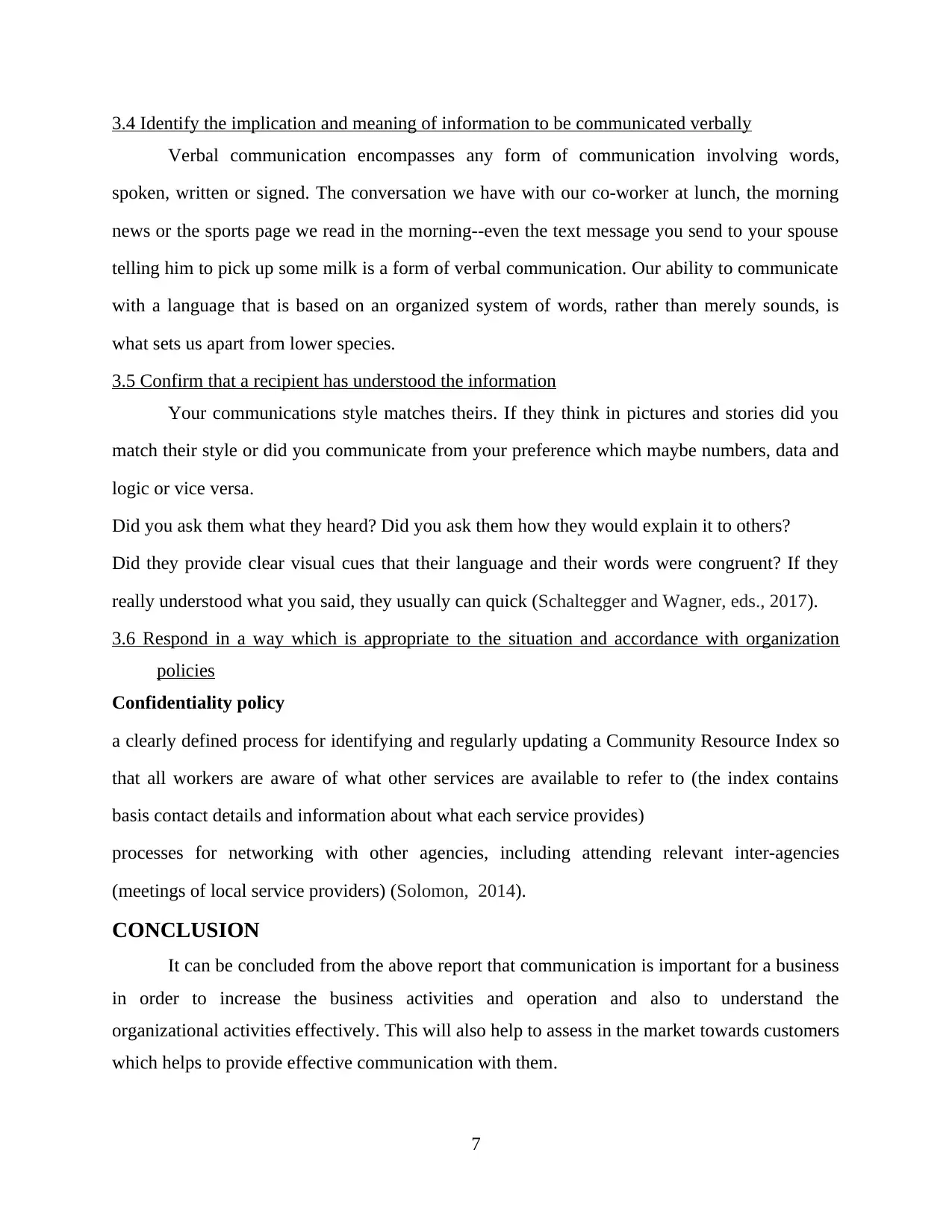
3.4 Identify the implication and meaning of information to be communicated verbally
Verbal communication encompasses any form of communication involving words,
spoken, written or signed. The conversation we have with our co-worker at lunch, the morning
news or the sports page we read in the morning--even the text message you send to your spouse
telling him to pick up some milk is a form of verbal communication. Our ability to communicate
with a language that is based on an organized system of words, rather than merely sounds, is
what sets us apart from lower species.
3.5 Confirm that a recipient has understood the information
Your communications style matches theirs. If they think in pictures and stories did you
match their style or did you communicate from your preference which maybe numbers, data and
logic or vice versa.
Did you ask them what they heard? Did you ask them how they would explain it to others?
Did they provide clear visual cues that their language and their words were congruent? If they
really understood what you said, they usually can quick (Schaltegger and Wagner, eds., 2017).
3.6 Respond in a way which is appropriate to the situation and accordance with organization
policies
Confidentiality policy
a clearly defined process for identifying and regularly updating a Community Resource Index so
that all workers are aware of what other services are available to refer to (the index contains
basis contact details and information about what each service provides)
processes for networking with other agencies, including attending relevant inter-agencies
(meetings of local service providers) (Solomon, 2014).
CONCLUSION
It can be concluded from the above report that communication is important for a business
in order to increase the business activities and operation and also to understand the
organizational activities effectively. This will also help to assess in the market towards customers
which helps to provide effective communication with them.
7
Verbal communication encompasses any form of communication involving words,
spoken, written or signed. The conversation we have with our co-worker at lunch, the morning
news or the sports page we read in the morning--even the text message you send to your spouse
telling him to pick up some milk is a form of verbal communication. Our ability to communicate
with a language that is based on an organized system of words, rather than merely sounds, is
what sets us apart from lower species.
3.5 Confirm that a recipient has understood the information
Your communications style matches theirs. If they think in pictures and stories did you
match their style or did you communicate from your preference which maybe numbers, data and
logic or vice versa.
Did you ask them what they heard? Did you ask them how they would explain it to others?
Did they provide clear visual cues that their language and their words were congruent? If they
really understood what you said, they usually can quick (Schaltegger and Wagner, eds., 2017).
3.6 Respond in a way which is appropriate to the situation and accordance with organization
policies
Confidentiality policy
a clearly defined process for identifying and regularly updating a Community Resource Index so
that all workers are aware of what other services are available to refer to (the index contains
basis contact details and information about what each service provides)
processes for networking with other agencies, including attending relevant inter-agencies
(meetings of local service providers) (Solomon, 2014).
CONCLUSION
It can be concluded from the above report that communication is important for a business
in order to increase the business activities and operation and also to understand the
organizational activities effectively. This will also help to assess in the market towards customers
which helps to provide effective communication with them.
7
Paraphrase This Document
Need a fresh take? Get an instant paraphrase of this document with our AI Paraphraser

REFERENCES
Books and Journals
Belás, J., Bartos, P., Habánik, J. and Novák, P., 2014. Significant attributes of the business
environment in small and meduim-sized enterprises. Economics & Sociology, 7(3), p.22.
Cohen, B. and Kietzmann, J., 2014. Ride on! Mobility business models for the sharing
economy. Organization & Environment, 27(3), pp.279-296.
Hardy, G. and Everett, D. eds., 2013. Shaping the Future of Business Education: Relevance,
Rigor, and Life Preparation. Springer.
Weiss, J.W., 2014. Business ethics: A stakeholder and issues management approach. Berrett-
Koehler Publishers.
Fleischmann, A., Schmidt, W., Stary, C., Obermeier, S. and Brger, E., 2014. Subject-oriented
business process management. Springer Publishing Company, Incorporated.
Ferraro, G.P. and Briody, E.K., 2017. The cultural dimension of global business. Taylor &
Francis.
Tukker, A. and Tischner, U. eds., 2017. New business for old Europe: product-service
development, competitiveness and sustainability. Routledge.
Schaltegger, S. and Wagner, M. eds., 2017. Managing the business case for sustainability: The
integration of social, environmental and economic performance. Routledge.
Solomon, M.R., 2014. Consumer behavior: Buying, having, and being (Vol. 10). Upper Saddle
River, NJ: Prentice Hall.
Chang, J.F., 2016. Business process management systems: strategy and implementation. CRC
Press.
Georgescu, M. and Popescul, D., 2015. Social Media–the new paradigm of collaboration and
communication for business environment. Procedia Economics and Finance, 20, pp.277-
282.
Wheelen, T.L. and Hunger, J.D., 2017. Strategic management and business policy. Pearson.
Neubauer, F. and Lank, A.G., 2016. The family business: Its governance for sustainability.
Springer.
Bocken, N.M.P., Short, S.W., Rana, P. and Evans, S., 2014. A literature and practice review to
develop sustainable business model archetypes. Journal of cleaner production, 65, pp.42-
56.
8
Books and Journals
Belás, J., Bartos, P., Habánik, J. and Novák, P., 2014. Significant attributes of the business
environment in small and meduim-sized enterprises. Economics & Sociology, 7(3), p.22.
Cohen, B. and Kietzmann, J., 2014. Ride on! Mobility business models for the sharing
economy. Organization & Environment, 27(3), pp.279-296.
Hardy, G. and Everett, D. eds., 2013. Shaping the Future of Business Education: Relevance,
Rigor, and Life Preparation. Springer.
Weiss, J.W., 2014. Business ethics: A stakeholder and issues management approach. Berrett-
Koehler Publishers.
Fleischmann, A., Schmidt, W., Stary, C., Obermeier, S. and Brger, E., 2014. Subject-oriented
business process management. Springer Publishing Company, Incorporated.
Ferraro, G.P. and Briody, E.K., 2017. The cultural dimension of global business. Taylor &
Francis.
Tukker, A. and Tischner, U. eds., 2017. New business for old Europe: product-service
development, competitiveness and sustainability. Routledge.
Schaltegger, S. and Wagner, M. eds., 2017. Managing the business case for sustainability: The
integration of social, environmental and economic performance. Routledge.
Solomon, M.R., 2014. Consumer behavior: Buying, having, and being (Vol. 10). Upper Saddle
River, NJ: Prentice Hall.
Chang, J.F., 2016. Business process management systems: strategy and implementation. CRC
Press.
Georgescu, M. and Popescul, D., 2015. Social Media–the new paradigm of collaboration and
communication for business environment. Procedia Economics and Finance, 20, pp.277-
282.
Wheelen, T.L. and Hunger, J.D., 2017. Strategic management and business policy. Pearson.
Neubauer, F. and Lank, A.G., 2016. The family business: Its governance for sustainability.
Springer.
Bocken, N.M.P., Short, S.W., Rana, P. and Evans, S., 2014. A literature and practice review to
develop sustainable business model archetypes. Journal of cleaner production, 65, pp.42-
56.
8

9
⊘ This is a preview!⊘
Do you want full access?
Subscribe today to unlock all pages.

Trusted by 1+ million students worldwide
1 out of 12
Related Documents
Your All-in-One AI-Powered Toolkit for Academic Success.
+13062052269
info@desklib.com
Available 24*7 on WhatsApp / Email
![[object Object]](/_next/static/media/star-bottom.7253800d.svg)
Unlock your academic potential
Copyright © 2020–2025 A2Z Services. All Rights Reserved. Developed and managed by ZUCOL.





